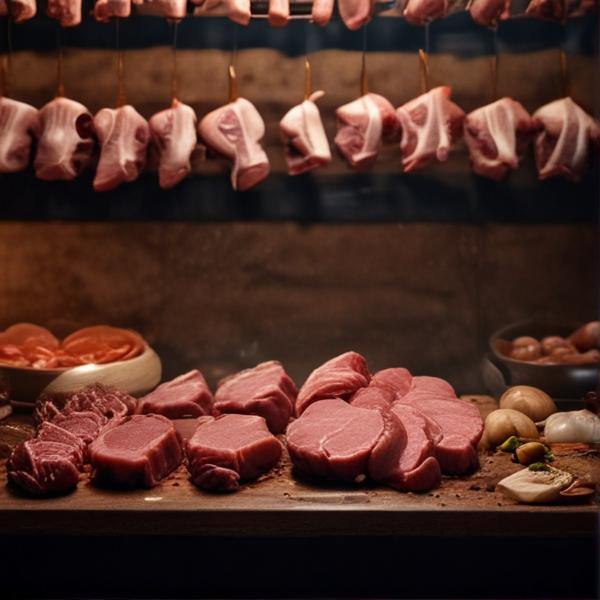基本信息 (Basic Information)
含义与用法 (Meanings & Usage)
中文核心释义 (Core Chinese Meaning): 动物的肌肉组织,主要指可食用的部分。
英文核心释义 (Core English Meaning): meat; flesh; muscular tissue of animals, especially as food.
“肉”最常指食用的动物肉,如猪肉、牛肉、鸡肉等,也可比喻身体上的肌肤或肉体。如“肉体”、“肉食”等表达。此外,“肉”在部分词语中也可引申为“本质”或“实体”。
'肉' most commonly refers to edible animal meat, like pork, beef, or chicken. It can also refer to the flesh or body in a figurative sense, as in '肉体' (bodily flesh). In certain phrases, it can also mean 'substance' or 'essence.'
象形意义 / 为何这么写 (Pictographic Meaning / Writing Rationale)
“肉”是象形字,字形描绘出肉块的外形和肌理纹路。外框代表肉块的轮廓,内部点或线表示纤维、肉筋或切割面,这种结构让人联想到真正的肉。'肉' is a pictographic character. Its shape illustrates a chunk of meat with contours and inner texture lines or dots to represent fibers or the inner structure, evoking the image of real meat.
文言文释义 (Classical Chinese Meaning)
与现代意义相近,通常指动物肌肉或人体肌肤。Similar to modern meaning, usually referring to animal muscle or human flesh.
深入学习 (In-depth Study)
字源故事 (Origin Story)
“肉”字起源于甲骨文,最初的字形像一块分割开的带有肌理的肉,表示动物身上的肉块。最早用于描述动物或人体的肌肉组织。The character '肉' originated in oracle bone script, where its earliest form resembled a piece of meat with visible textures and lines, indicating a chunk of flesh. It was first used to describe the muscular tissue of animals or humans.
字形演变 (Character Evolution)
甲骨文 (Oracle Bone Script):
甲骨文中的“肉”字通常像一个有分叉的图形,中间画有纹理线条,象征肉的纤维和分割面。
In Oracle Bone Script, '肉' was often depicted as a shape with branching lines inside, representing the fibers and cut surfaces of meat.
金文 (Bronze Inscription):
金文中的“肉”字形体趋于方正,内部的肌理线条更加明显,外框也更为规整,继续保留了肉块的象形特点。
In Bronze Inscription, the form of '肉' became more rectangular, with more distinct inner texture lines, and a clearer outline, still maintaining its pictographic shape of a chunk of meat.
小篆 (Small Seal Script):
小篆中的“肉”字体变得更为对称,曲线化,内部竖线简化为几条,有肌理结构的表现。
In Small Seal Script, '肉' became more symmetrical, with curvier lines; the texture inside was simplified into vertical lines, still expressing the idea of meat tissue.
隶书 (Clerical Script):
隶书中的“肉”结构扁平化,笔画横平竖直,内部线条更为简化,已接近现代字形。
In Clerical Script, the structure of '肉' became more flattened with straight horizontal and vertical strokes; the inner lines were further simplified, closely resembling the modern form.
楷书 (现代) (Regular Script (Modern)):
现代楷书中“肉”字为四画,外框呈口状,内部两点象征肉的纤维,标准书写规范。
In modern Regular Script, '肉' consists of four strokes with a square outer shape and two dots inside representing the fibers of meat, according to the standard script rules.
常用词语和例句 (Common Words & Examples)
鸡肉 (chicken meat)
我喜欢吃鸡肉。
Eng: I like to eat chicken.
肉体 (the body; flesh)
人不仅有肉体,还有精神。
Eng: A person has not only the body, but also the spirit.
牛肉 (beef)
牛肉面很好吃。
Eng: Beef noodles are delicious.
相关成语 (Related Idioms)
望梅止渴,画饼充饥
Meaning: To console oneself with imagined things; to feed on illusions.
古时有士兵饥渴难耐,将军告诉他们前面有梅子,激发了口中的津液,暂时解渴。另有画饼充饥,意指画出肉饼,只能望而不能吃,形容空想无法解决实际问题。
In ancient times, thirsty soldiers were consoled by their general, who described sour plums ahead, making their mouths water and temporarily easing thirst. Similarly, 'drawing meat pies' refers to imagining food that can't be eaten, symbolizing that empty imaginings can't solve real problems.
多语言翻译 (核心释义) (Translations (Core Meaning))
- French: viande
- German: Fleisch
- Spanish: carne
- Italian: carne
- Portuguese: carne
- Russian: мясо
- Arabic: لحم
- Persian: گوشت
- Dutch: vlees
- Polish: mięso
- Vietnamese: thịt
- Ukrainian: м'ясо
视频学习资源 (Video Learning Resources)
通过以下链接在热门视频网站搜索 "肉" 的更多讲解:
Search for more explanations of "肉" on popular video sites:
- 在 Bilibili.com 搜索 "肉 字源 说文解字" (Search on Bilibili)
- 在 YouTube.com 搜索 "肉 character origin etymology" (Search on YouTube)
网络参考 (Web References for "肉") ()
网络搜索信息待获取。Web search information pending.
更多图片 (肉 More Images) ()
